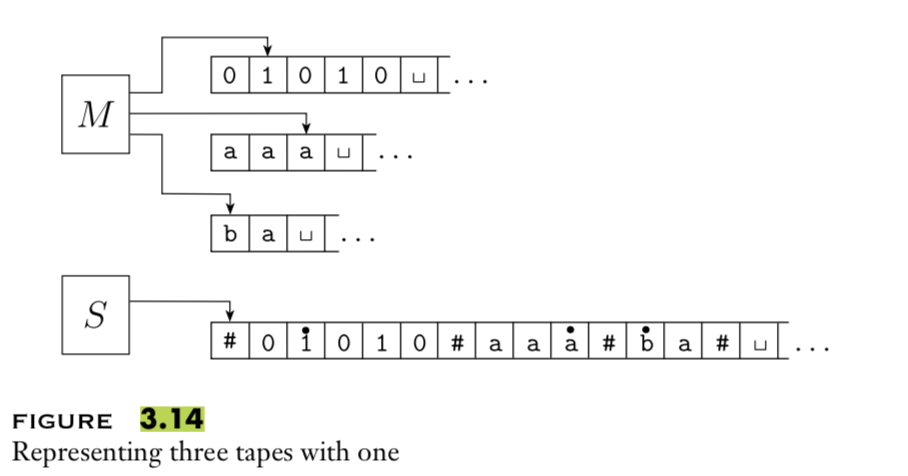
Two models of computation are called equally expressive when every language recognizable with the first model is recognizable with the second, and vice versa.
True / False: NFAs and PDAs are equally expressive.
True / False: Regular expressions and CFGs are equally expressive.
Church-Turing Thesis (Sipser p. 183): The informal notion of algorithm is formalized completely and correctly by the formal definition of a Turing machine. In other words: all reasonably expressive models of computation are equally expressive with the standard Turing machine.
Some examples of models that are equally expressive with deterministic Turing machines:
The May-stay machine model is the same as the usual Turing machine model, except that on each transition, the tape head may move L, move R, or Stay.
Formally: \((Q, \Sigma, \Gamma, \delta, q_0, q_{accept}, q_{reject})\) where \[\delta: Q \times \Gamma \to Q \times \Gamma \times \{L, R, S\}\]
Claim: Turing machines and May-stay machines are equally expressive. To prove …
To translate a standard TM to a may-stay machine: never use the direction \(S\)!
To translate one of the may-stay machines to standard TM: any time TM would Stay, move right then left.
A multitape Turing macihne with \(k\) tapes can be formally representated as \((Q, \Sigma, \Gamma, \delta, q_0, q_{acc}, q_{rej})\) where \(Q\) is the finite set of states, \(\Sigma\) is the input alphabet with \(\textvisiblespace \notin \Sigma\), \(\Gamma\) is the tape alphabet with \(\Sigma \subsetneq \Gamma\) , \(\delta: Q\times \Gamma^k\to Q \times \Gamma^k \times \{L,R\}^k\) (where \(k\) is the number of states)
If \(M\) is a standard TM, it is a \(1\)-tape machine.
To translate a \(k\)-tape machine to a standard TM: Use a new symbol to separate the contents of each tape and keep track of location of head with special version of each tape symbol. Sipser Theorem 3.13

Enumerators give a different model of computation where a language is produced, one string at a time, rather than recognized by accepting (or not) individual strings.
Each enumerator machine has finite state control, unlimited work tape, and a printer. The computation proceeds according to transition function; at any point machine may “send” a string to the printer. \[E = (Q, \Sigma, \Gamma, \delta, q_0, q_{print})\] \(Q\) is the finite set of states, \(\Sigma\) is the output alphabet, \(\Gamma\) is the tape alphabet (\(\Sigma \subsetneq\Gamma, \textvisiblespace \in \Gamma \setminus \Sigma\)), \[\delta: Q \times \Gamma \times \Gamma \to Q \times \Gamma \times \Gamma \times \{L, R\} \times \{L, R\}\] where in state \(q\), when the working tape is scanning character \(x\) and the printer tape is scanning character \(y\), \(\delta( (q,x,y) ) = (q', x', y', d_w, d_p)\) means transition to control state \(q'\), write \(x'\) on the working tape, write \(y'\) on the printer tape, move in direction \(d_w\) on the working tape, and move in direction \(d_p\) on the printer tape. The computation starts in \(q_0\) and each time the computation enters \(q_{print}\) the string from the leftmost edge of the printer tape to the first blank cell is considered to be printed.
The language enumerated by \(E\), \(L(E)\), is \(\{ w \in \Sigma^* \mid \text{$E$ eventually, at finite time, prints $w$} \}\).
Theorem 3.21 A language is Turing-recognizable iff some enumerator enumerates it.
Proof, part 1: Assume \(L\) is enumerated by some enumerator, \(E\), so \(L = L(E)\). We’ll use \(E\) in a subroutine within a high-level description of a new Turing machine that we will build to recognize \(L\).
Goal: build Turing machine \(M_E\) with \(L(M_E) = L(E)\).
Define \(M_E\) as follows: \(M_E =\) “On input \(w\),
Run \(E\). For each string \(x\) printed by \(E\).
Check if \(x = w\). If so, accept (and halt); otherwise, continue."
Proof, part 2: Assume \(L\) is Turing-recognizable and there is a Turing machine \(M\) with \(L = L(M)\). We’ll use \(M\) in a subroutine within a high-level description of an enumerator that we will build to enumerate \(L\).
Goal: build enumerator \(E_M\) with \(L(E_M) = L(M)\).
Idea: check each string in turn to see if it is in \(L\).
How? Run computation of \(M\) on each string. But: need to be careful about computations that don’t halt.
Recall String order for \(\Sigma = \{0,1\}\): \(s_1 = \varepsilon\), \(s_2 = 0\), \(s_3 = 1\), \(s_4 = 00\), \(s_5 = 01\), \(s_6 = 10\), \(s_7 = 11\), \(s_8 = 000\), …
Define \(E_M\) as follows: \(E_{M} =\) “ ignore any input. Repeat the following for \(i=1, 2, 3, \ldots\)
Run the computations of \(M\) on \(s_1\), \(s_2\), …, \(s_i\) for (at most) \(i\) steps each
For each of these \(i\) computations that accept during the (at most) \(i\) steps, print out the accepted string."
At any point in the computation, the nondeterministic machine may proceed according to several possibilities: \((Q, \Sigma, \Gamma, \delta, q_0, q_{acc}, q_{rej})\) where \[\delta: Q \times \Gamma \to \mathcal{P}(Q \times \Gamma \times \{L, R\})\] The computation of a nondeterministic Turing machine is a tree with branching when the next step of the computation has multiple possibilities. A nondeterministic Turing machine accepts a string exactly when some branch of the computation tree enters the accept state.
Given a nondeterministic machine, we can use a \(3\)-tape Turing machine to simulate it by doing a breadth-first search of computation tree: one tape is “read-only” input tape, one tape simulates the tape of the nondeterministic computation, and one tape tracks nondeterministic branching. Sipser page 178
Summary
Two models of computation are called equally expressive when every language recognizable with the first model is recognizable with the second, and vice versa.
To prove the existence of a Turing machine that decides / recognizes some language, it’s enough to construct an example using any of the equally expressive models.
But: some of the performance properties of these models are not equivalent.
Regular sets are not the end of the story
Many nice / simple / important sets are not regular
Limitation of the finite-state automaton model: Can’t “count", Can only remember finitely far into the past, Can’t backtrack, Must make decisions in “real-time"
We know actual computers are more powerful than this model...
The next model of computation. Idea: allow some memory of unbounded size. How?
To generalize regular expressions: context-free
grammars
To generalize NFA: Pushdown automata, which is like an NFA with access to a stack: Number of states is fixed, number of entries in stack is unbounded. At each step (1) Transition to new state based on current state, letter read, and top letter of stack, then (2) (Possibly) push or pop a letter to (or from) top of stack. Accept a string iff there is some sequence of states and some sequence of stack contents which helps the PDA processes the entire input string and ends in an accepting state.
Is there a PDA that recognizes the nonregular language \(\{0^n1^n \mid n \geq 0 \}\)?

The PDA with state diagram above can be informally described as:
Read symbols from the input. As each 0 is read, push it onto the stack. As soon as 1s are seen, pop a 0 off the stack for each 1 read. If the stack becomes empty and we are at the end of the input string, accept the input. If the stack becomes empty and there are 1s left to read, or if 1s are finished while the stack still contains 0s, or if any 0s appear in the string following 1s, reject the input.
Trace the computation of this PDA on the input string \(01\).
Trace the computation of this PDA on the input string \(011\).
A PDA recognizing the set \(\{ \hspace{1.5 in} \}\) can be informally described as:
Read symbols from the input. As each 0 is read, push it onto the stack. As soon as 1s are seen, pop a 0 off the stack for each 1 read. If the stack becomes empty and there is exactly one 1 left to read, read that 1 and accept the input. If the stack becomes empty and there are either zero or more than one 1s left to read, or if the 1s are finished while the stack still contains 0s, or if any 0s appear in the input following 1s, reject the input.
Modify the state diagram below to get a PDA that implements this description:

Definition A pushdown automaton (PDA) is specified by a \(6\)-tuple \((Q, \Sigma, \Gamma, \delta, q_0, F)\) where \(Q\) is the finite set of states, \(\Sigma\) is the input alphabet, \(\Gamma\) is the stack alphabet, \[\delta: Q \times \Sigma_\varepsilon \times \Gamma_\varepsilon \to \mathcal{P}( Q \times \Gamma_\varepsilon)\] is the transition function, \(q_0 \in Q\) is the start state, \(F \subseteq Q\) is the set of accept states.
Draw the state diagram and give the formal definition of a PDA with \(\Sigma = \Gamma\).
Draw the state diagram and give the formal definition of a PDA with \(\Sigma \cap \Gamma = \emptyset\).
For the PDA state diagrams below, \(\Sigma = \{0,1\}\).
| Mathematical description of language | State diagram of PDA recognizing language |
|---|---|
| \(\Gamma = \{ \$, \#\}\) | |
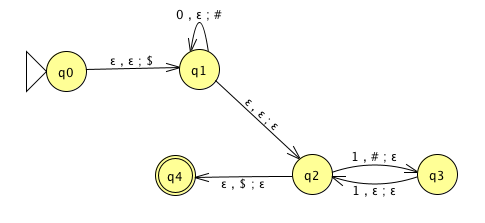 |
|
| \(\Gamma = \{ {@}, 1\}\) | |
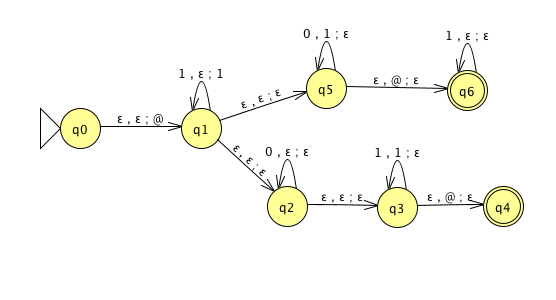 |
|
| \(\{ 0^i 1^j 0^k \mid i,j,k \geq 0 \}\) | |
Note: alternate notation is to replace \(;\) with \(\to\)
Big picture: PDAs were motivated by wanting to add some memory of unbounded size to NFA. How do we accomplish a similar enhancement of regular expressions to get a syntactic model that is more expressive?
DFA, NFA, PDA: Machines process one input string at a time; the computation of a machine on its input string reads the input from left to right.
Regular expressions: Syntactic descriptions of all strings that match a particular pattern; the language described by a regular expression is built up recursively according to the expression’s syntax
Context-free grammars: Rules to produce one string at a time, adding characters from the middle, beginning, or end of the final string as the derivation proceeds.
Warmup: Design a DFA (deterministic finite automaton) and an NFA (nondeterministic finite automaton) that each recognize each of the following languages over \(\{a,b\}\) \[\{ w \mid \text{$w$ has an $a$ and ends in $b$}\}\]
\[\{ w \mid \text{$w$ has an $a$ or ends in $b$}\}\]
Strategy: To design DFA or NFA for a given language, identify patterns that can be built up as we process strings and create states for intermediate stages. Or: decompose the language to a simpler one that we already know how to recognize with a DFA or NFA.
Recall (from Wednesday of last week, and in textbook Exercise 1.14): if there is a DFA \(M\) such that \(L(M) = A\) then there is another DFA, let’s call it \(M'\), such that \(L(M') = \overline{A}\), the complement of \(A\), defined as \(\{ w \in \Sigma^* \mid w \notin A \}\).
Let’s practice defining automata constructions by coming up with other ways to get new automata from old.
Suppose \(A_1, A_2\) are languages over an alphabet \(\Sigma\). Claim: if there is a NFA \(N_1\) such that \(L(N_1) = A_1\) and NFA \(N_2\) such that \(L(N_2) = A_2\), then there is another NFA, let’s call it \(N\), such that \(L(N) = A_1 \cup A_2\).
Proof idea: Use nondeterminism to choose which of \(N_1\), \(N_2\) to run.
Formal construction: Let \(N_1 = (Q_1, \Sigma, \delta_1, q_1, F_1)\) and \(N_2 = (Q_2, \Sigma, \delta_2,q_2, F_2)\) and assume \(Q_1 \cap Q_2 = \emptyset\) and that \(q_0 \notin Q_1 \cup Q_2\). Construct \(N = (Q, \Sigma, \delta, q_0, F_1 \cup F_2)\) where
\(Q =\)
\(\delta: Q \times \Sigma_\varepsilon \to \mathcal{P}(Q)\) is defined by, for \(q \in Q\) and \(x \in \Sigma_{\varepsilon}\): \[\phantom{\delta((q,x))=\begin{cases} \delta_1 ((q,x)) &\qquad\text{if } q\in Q_1 \\ \delta_2 ((q,x)) &\qquad\text{if } q\in Q_2 \\ \{q1,q2\} &\qquad\text{if } q = q_0, x = \varepsilon \\ \emptyset\text{if } q= q_0, x \neq \varepsilon \end{cases}}\]
Proof of correctness would prove that \(L(N) = A_1 \cup A_2\) by considering an arbitrary string accepted by \(N\), tracing an accepting computation of \(N\) on it, and using that trace to prove the string is in at least one of \(A_1\), \(A_2\); then, taking an arbitrary string in \(A_1 \cup A_2\) and proving that it is accepted by \(N\). Details left for extra practice.
Example: The language recognized by the NFA over \(\{a,b\}\) with state diagram
is:
Could we do the same construction with DFA?
Happily, though, an analogous claim is true!
Suppose \(A_1, A_2\) are languages over an alphabet \(\Sigma\). Claim: if there is a DFA \(M_1\) such that \(L(M_1) = A_1\) and DFA \(M_2\) such that \(L(M_2) = A_2\), then there is another DFA, let’s call it \(M\), such that \(L(M) = A_1 \cup A_2\). Theorem 1.25 in Sipser, page 45
Proof idea:
Formal construction:
Example: When \(A_1 = \{w \mid w~\text{has an $a$ and ends in $b$} \}\) and \(A_2 = \{ w \mid w~\text{is of even length} \}\).
Suppose \(A_1, A_2\) are languages over an alphabet \(\Sigma\). Claim: if there is a DFA \(M_1\) such that \(L(M_1) = A_1\) and DFA \(M_2\) such that \(L(M_2) = A_2\), then there is another DFA, let’s call it \(M\), such that \(L(M) = A_1 \cap A_2\). Sipser Theorem 1.25, page 45
Proof idea:
Formal construction:
So far we have that:
If there is a DFA recognizing a language, there is a DFA recognizing its complement.
If there are NFA recognizing two languages, there is a NFA recognizing their union.
If there are DFA recognizing two languages, there is a DFA recognizing their union.
If there are DFA recognizing two languages, there is a DFA recognizing their intersection.
Our goals for today are (1) prove similar results about other set operations, (2) prove that NFA and DFA are equally expressive, and therefore (3) define an important class of languages.
Suppose \(A_1, A_2\) are languages over an alphabet \(\Sigma\). Claim: if there is a NFA \(N_1\) such that \(L(N_1) = A_1\) and NFA \(N_2\) such that \(L(N_2) = A_2\), then there is another NFA, let’s call it \(N\), such that \(L(N) = A_1 \circ A_2\).
Proof idea: Allow computation to move between \(N_1\) and \(N_2\) “spontaneously" when reach an accepting state of \(N_1\), guessing that we’ve reached the point where the two parts of the string in the set-wise concatenation are glued together.
Formal construction: Let \(N_1 = (Q_1, \Sigma, \delta_1, q_1, F_1)\) and \(N_2 = (Q_2, \Sigma, \delta_2,q_2, F_2)\) and assume \(Q_1 \cap Q_2 = \emptyset\). Construct \(N = (Q, \Sigma, \delta, q_0, F)\) where
\(Q =\)
\(q_0 =\)
\(F =\)
\(\delta: Q \times \Sigma_\varepsilon \to \mathcal{P}(Q)\) is defined by, for \(q \in Q\) and \(a \in \Sigma_{\varepsilon}\): \[\delta((q,a))=\begin{cases} \delta_1 ((q,a)) &\qquad\text{if } q\in Q_1 \textrm{ and } q \notin F_1\\ \delta_1 ((q,a)) &\qquad\text{if } q\in F_1 \textrm{ and } a \in \Sigma\\ \delta_1 ((q,a)) \cup \{q_2\} &\qquad\text{if } q\in F_1 \textrm{ and } a = \varepsilon\\ \delta_2 ((q,a)) &\qquad\text{if } q\in Q_2 \end{cases}\]
Proof of correctness would prove that \(L(N) = A_1 \circ A_2\) by considering an arbitrary string accepted by \(N\), tracing an accepting computation of \(N\) on it, and using that trace to prove the string can be written as the result of concatenating two strings, the first in \(A_1\) and the second in \(A_2\); then, taking an arbitrary string in \(A_1 \circ A_2\) and proving that it is accepted by \(N\). Details left for extra practice.
Suppose \(A\) is a language over an alphabet \(\Sigma\). Claim: if there is a NFA \(N\) such that \(L(N) = A\), then there is another NFA, let’s call it \(N'\), such that \(L(N') = A^*\).
Proof idea: Add a fresh start state, which is an accept state. Add spontaneous moves from each (old) accept state to the old start state.
Formal construction: Let \(N = (Q, \Sigma, \delta, q_1, F)\) and assume \(q_0 \notin Q\). Construct \(N' = (Q', \Sigma, \delta', q_0, F')\) where
\(Q' = Q \cup \{q_0\}\)
\(F' = F \cup \{q_0\}\)
\(\delta': Q' \times \Sigma_\varepsilon \to \mathcal{P}(Q')\) is defined by, for \(q \in Q'\) and \(a \in \Sigma_{\varepsilon}\): \[\delta'((q,a))=\begin{cases} \delta ((q,a)) &\qquad\text{if } q\in Q \textrm{ and } q \notin F\\ \delta ((q,a)) &\qquad\text{if } q\in F \textrm{ and } a \in \Sigma\\ \delta ((q,a)) \cup \{q_1\} &\qquad\text{if } q\in F \textrm{ and } a = \varepsilon\\ \{q_1\} &\qquad\text{if } q = q_0 \textrm{ and } a = \varepsilon \\ \emptyset &\qquad\text{if } q = q_0 \textrm { and } a \in \Sigma \end{cases}\]
Proof of correctness would prove that \(L(N') = A^*\) by considering an arbitrary string accepted by \(N'\), tracing an accepting computation of \(N'\) on it, and using that trace to prove the string can be written as the result of concatenating some number of strings, each of which is in \(A\); then, taking an arbitrary string in \(A^*\) and proving that it is accepted by \(N'\). Details left for extra practice.
Application: A state diagram for a NFA over \(\Sigma = \{a,b\}\) that recognizes \(L (( a^*b)^* )\):
Suppose \(A\) is a language over an alphabet \(\Sigma\). Claim: if there is a NFA \(N\) such that \(L(N) = A\) then there is a DFA \(M\) such that \(L(M) = A\).
Proof idea: States in \(M\) are “macro-states" – collections of states from \(N\) – that represent the set of possible states a computation of \(N\) might be in.
Formal construction: Let \(N = (Q, \Sigma, \delta, q_0, F)\). Define \[M = (~ \mathcal{P}(Q), \Sigma, \delta', q', \{ X \subseteq Q \mid X \cap F \neq \emptyset \}~ )\] where \(q' = \{ q \in Q \mid \text{$q = q_0$ or is accessible from $q_0$ by spontaneous moves in $N$} \}\) and \[\delta' (~(X, x)~) = \{ q \in Q \mid q \in \delta( ~(r,x)~) ~\text{for some $r \in X$ or is accessible from such an $r$ by spontaneous moves in $N$} \}\]
Consider the state diagram of an NFA over \(\{a,b\}\). Use the “macro-state” construction to find an equivalent DFA.

Consider the state diagram of an NFA over \(\{0,1\}\). Use the “macro-state” construction to find an equivalent DFA.

Note: We can often prune the DFAs that result from the “macro-state” constructions to get an equivalent DFA with fewer states (e.g. only the “macro-states" reachable from the start state).
The class of regular languages
Fix an alphabet \(\Sigma\). For each language \(L\) over \(\Sigma\):
| There is a DFA over \(\Sigma\) that recognizes \(L\) | \(\exists M ~(M \textrm{ is a DFA and } L(M) = A)\) |
| if and only if | |
| There is a NFA over \(\Sigma\) that recognizes \(L\) | \(\exists N ~(N \textrm{ is a NFA and } L(N) = A)\) |
| if and only if | |
| There is a regular expression over \(\Sigma\) that describes \(L\) | \(\exists R ~(R \textrm{ is a regular expression and } L(R) = A)\) |
A language is called regular when any (hence all) of the above three conditions are met.
We already proved that DFAs and NFAs are equally expressive. It remains to prove that regular expressions are too.
Part 1: Suppose \(A\) is a language over an alphabet \(\Sigma\). If there is a regular expression \(R\) such that \(L(R) = A\), then there is a NFA, let’s call it \(N\), such that \(L(N) = A\).
Structural induction: Regular expression is built from basis regular expressions using inductive steps (union, concatenation, Kleene star symbols). Use constructions to mirror these in NFAs.
Application: A state diagram for a NFA over \(\{a,b\}\) that recognizes \(L(a^* (ab)^*)\):
Part 2: Suppose \(A\) is a language over an alphabet \(\Sigma\). If there is a DFA \(M\) such that \(L(M) = A\), then there is a regular expression, let’s call it \(R\), such that \(L(R) = A\).
Proof idea: Trace all possible paths from start state to accept state. Express labels of these paths as regular expressions, and union them all.
Add new start state with \(\varepsilon\) arrow to old start state.
Add new accept state with \(\varepsilon\) arrow from old accept states. Make old accept states non-accept.
Remove one (of the old) states at a time: modify regular expressions on arrows that went through removed state to restore language recognized by machine.
Application: Find a regular expression describing the language recognized by the DFA with state diagram
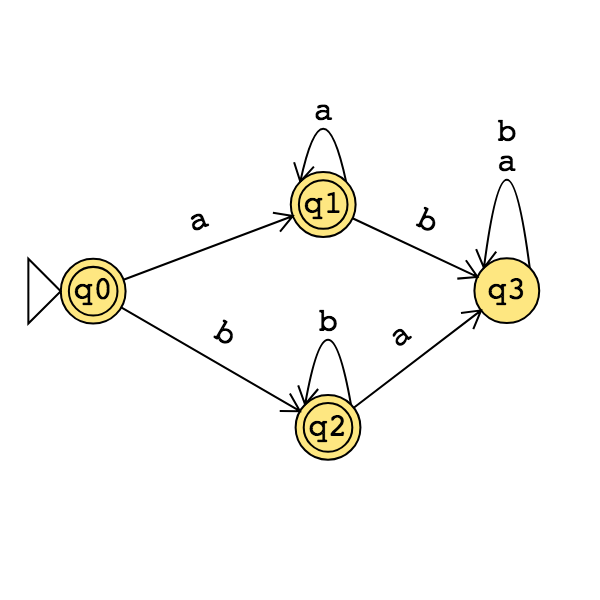
| Nondeterministic finite automaton (Sipser Page 53) Given as \(M = (Q, \Sigma, \delta, q_0, F)\) | |
| Finite set of states \(Q\) | Can be labelled by any collection of distinct names. Default: \(q0, q1, \ldots\) |
| Alphabet \(\Sigma\) | Each input to the automaton is a string over \(\Sigma\). |
| Arrow labels \(\Sigma_\varepsilon\) | \(\Sigma_\varepsilon = \Sigma \cup \{ \varepsilon\}\). |
| Arrows in the state diagram are labelled either by symbols from \(\Sigma\) or by \(\varepsilon\) | |
| Transition function \(\delta\) | \(\delta: Q \times \Sigma_{\varepsilon} \to \mathcal{P}(Q)\) gives the set of possible next states for a transition |
| from the current state upon reading a symbol or spontaneously moving. | |
| Start state \(q_0\) | Element of \(Q\). Each computation of the machine starts at the start state. |
| Accept (final) states \(F\) | \(F \subseteq Q\). |
| \(M\) accepts the input string \(w \in \Sigma^*\) if and only if there is a computation of \(M\) on \(w\) that processes the whole string and ends in an accept state. | |
The formal definition of the NFA over \(\{0,1\}\) given by this state diagram is:
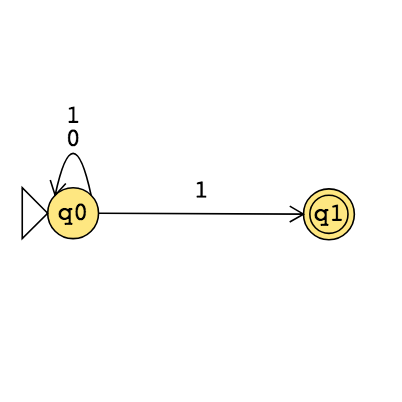
The language over \(\{0,1\}\) recognized by this NFA is:
Change the transition function to get a different NFA which accepts the empty string (and potentially other strings too).
The state diagram of an NFA over \(\{a,b\}\) is below. The formal definition of this NFA is:
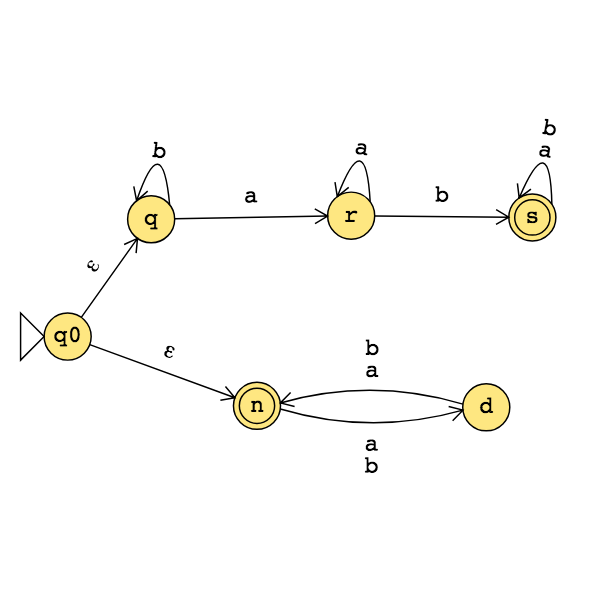
The language recognized by this NFA is:
In practice, computers (and Turing machines) don’t have infinite tape, and we can’t afford to wait unboundedly long for an answer. “Decidable" isn’t good enough - we want “Efficiently decidable".
For a given algorithm working on a given input, how long do we need to wait for an answer? How does the running time depend on the input in the worst-case? average-case? We expect to have to spend more time on computations with larger inputs.
A language is recognizable if
A language is decidable if
A language is efficiently decidable if
A function is computable if
A function is efficiently computable if
Definition (Sipser 7.1): For \(M\) a deterministic decider, its running time is the function \(f: \mathbb{N} \to \mathbb{N}\) given by \[f(n) = \text{max number of steps $M$ takes before halting, over all inputs of length $n$}\]
Definition (Sipser 7.7): For each function \(t(n)\), the time complexity class \(TIME(t(n))\), is defined by \[TIME( t(n)) = \{ L \mid \text{$L$ is decidable by a Turing machine with running time in $O(t(n))$} \}\]
An example of an element of \(TIME( 1 )\) is
An example of an element of \(TIME( n )\) is
Note: \(TIME( 1) \subseteq TIME (n) \subseteq TIME(n^2)\)
Definition (Sipser 7.12) : \(P\) is the class of languages that are decidable in polynomial time on a deterministic 1-tape Turing machine \[P = \bigcup_k TIME(n^k)\]
Compare to exponential time: brute-force search.
Theorem (Sipser 7.8): Let \(t(n)\) be a function with \(t(n) \geq n\). Then every \(t(n)\) time deterministic multitape Turing machine has an equivalent \(O(t^2(n))\) time deterministic 1-tape Turing machine.
Definition (Sipser 7.1): For \(M\) a deterministic decider, its running time is the function \(f: \mathbb{N} \to \mathbb{N}\) given by \[f(n) = \text{max number of steps $M$ takes before halting, over all inputs of length $n$}\]
Definition (Sipser 7.7): For each function \(t(n)\), the time complexity class \(TIME(t(n))\), is defined by \[TIME( t(n)) = \{ L \mid \text{$L$ is decidable by a Turing machine with running time in $O(t(n))$} \}\] Definition (Sipser 7.12) : \(P\) is the class of languages that are decidable in polynomial time on a deterministic 1-tape Turing machine \[P = \bigcup_k TIME(n^k)\]
Definition (Sipser 7.9): For \(N\) a nodeterministic decider. The running time of \(N\) is the function \(f: \mathbb{N} \to \mathbb{N}\) given by \[f(n) = \text{max number of steps $N$ takes on any branch before halting, over all inputs of length $n$}\]
Definition (Sipser 7.21): For each function \(t(n)\), the nondeterministic time complexity class \(NTIME(t(n))\), is defined by \[NTIME( t(n)) = \{ L \mid \text{$L$ is decidable by a nondeterministic Turing machine with running time in $O(t(n))$} \}\] \[NP = \bigcup_k NTIME(n^k)\]
True or False: \(TIME(n^2) \subseteq NTIME(n^2)\)
True or False: \(NTIME(n^2) \subseteq TIME(n^2)\)
Every problem in NP is decidable with an exponential-time algorithm
Nondeterministic approach: guess a possible solution, verify that it works.
Brute-force (worst-case exponential time) approach: iterate over all possible solutions, for each one, check if it works.
Examples in \(P\)
Can’t use nondeterminism; Can use multiple tapes; Often need to be “more clever” than naïve / brute force approach \[PATH = \{\langle G,s,t\rangle \mid \textrm{$G$ is digraph with $n$ nodes there is path from s to t}\}\] Use breadth first search to show in \(P\) \[RELPRIME = \{ \langle x,y\rangle \mid \textrm{$x$ and $y$ are relatively prime integers}\}\] Use Euclidean Algorithm to show in \(P\) \[L(G) = \{w \mid \textrm{$w$ is generated by $G$}\}\] (where \(G\) is a context-free grammar). Use dynamic programming to show in \(P\).
Examples in \(NP\)
“Verifiable" i.e. NP, Can be decided by a nondeterministic TM in polynomial time, best known deterministic solution may be brute-force, solution can be verified by a deterministic TM in polynomial time.
\[HAMPATH = \{\langle G,s,t \rangle \mid \textrm{$G$ is digraph with $n$ nodes, there is path from $s$ to $t$ that goes through every node exactly once}\}\] \[VERTEX-COVER = \{ \langle G,k\rangle \mid \textrm{$G$ is an undirected graph with $n$ nodes that has a $k$-node vertex cover}\}\] \[CLIQUE = \{ \langle G,k\rangle \mid \textrm{$G$ is an undirected graph with $n$ nodes that has a $k$-clique}\}\] \[SAT =\{ \langle X \rangle \mid \textrm{$X$ is a satisfiable Boolean formula with $n$ variables}\}\]
| Problems in \(P\) | Problems in \(NP\) |
|---|---|
| (Membership in any) regular language | Any problem in \(P\) |
| (Membership in any) context-free language | |
| \(A_{DFA}\) | \(SAT\) |
| \(E_{DFA}\) | \(CLIQUE\) |
| \(EQ_{DFA}\) | \(VERTEX-COVER\) |
| \(PATH\) | \(HAMPATH\) |
| \(RELPRIME\) | \(\ldots\) |
| \(\ldots\) |
Notice: \(NP \subseteq \{ L \mid L \text{ is decidable} \}\) so \(A_{TM} \notin NP\)
Million-dollar question: Is \(P = NP\)?
One approach to trying to answer it is to look for hardest problems in \(NP\) and then (1) if we can show that there are efficient algorithms for them, then we can get efficient algorithms for all problems in \(NP\) so \(P = NP\), or (2) these problems might be good candidates for showing that there are problems in \(NP\) for which there are no efficient algorithms.
Definition (Sipser 7.29) Language \(A\) is polynomial-time mapping reducible to language \(B\), written \(A \leq_P B\), means there is a polynomial-time computable function \(f: \Sigma^* \to \Sigma^*\) such that for every \(x \in \Sigma^*\) \[x \in A \qquad \text{iff} \qquad f(x) \in B.\] The function \(f\) is called the polynomial time reduction of \(A\) to \(B\).
Theorem (Sipser 7.31): If \(A \leq_P B\) and \(B \in P\) then \(A \in P\).
Proof:
Definition (Sipser 7.34; based in Stephen Cook and Leonid Levin’s work in the 1970s): A language \(B\) is NP-complete means (1) \(B\) is in NP and (2) every language \(A\) in \(NP\) is polynomial time reducible to \(B\).
Theorem (Sipser 7.35): If \(B\) is NP-complete and \(B \in P\) then \(P = NP\).
Proof:
3SAT: A literal is a Boolean variable (e.g. \(x\)) or a negated Boolean variable (e.g. \(\bar{x}\)). A Boolean formula is a 3cnf-formula if it is a Boolean formula in conjunctive normal form (a conjunction of disjunctive clauses of literals) and each clause has three literals. \[3SAT = \{ \langle \phi \rangle \mid \text{$\phi$ is a satisfiable 3cnf-formula} \}\]
Example string in \(3SAT\) \[\langle (x \vee \bar{y} \vee {\bar z}) \wedge (\bar{x} \vee y \vee z) \wedge (x \vee y \vee z) \rangle\]
Example string not in \(3SAT\) \[\langle (x \vee y \vee z) \wedge (x \vee y \vee{\bar z}) \wedge (x \vee \bar{y} \vee z) \wedge (x \vee \bar{y} \vee \bar{z}) \wedge (\bar{x} \vee y \vee z) \wedge (\bar{x} \vee y \vee{\bar z}) \wedge (\bar{x} \vee \bar{y} \vee z) \wedge (\bar{x} \vee \bar{y} \vee \bar{z}) \rangle\]
Cook-Levin Theorem: \(3SAT\) is \(NP\)-complete.
Are there other \(NP\)-complete problems? To prove that \(X\) is \(NP\)-complete
From scratch: prove \(X\) is in \(NP\) and that all \(NP\) problems are polynomial-time reducible to \(X\).
Using reduction: prove \(X\) is in \(NP\) and that a known-to-be \(NP\)-complete problem is polynomial-time reducible to \(X\).
CLIQUE: A \(k\)-clique in an undirected graph is a maximally connected subgraph with \(k\) nodes. \[CLIQUE = \{ \langle G, k \rangle \mid \text{$G$ is an undirected graph with a $k$-clique} \}\]
Example string in \(CLIQUE\)
Example string not in \(CLIQUE\)
Theorem (Sipser 7.32): \[3SAT \leq_P CLIQUE\]
Given a Boolean formula in conjunctive normal form with \(k\) clauses and three literals per clause, we will map it to a graph so that the graph has a clique if the original formula is satisfiable and the graph does not have a clique if the original formula is not satisfiable.
The graph has \(3k\) vertices (one for each literal in each clause) and an edge between all vertices except
vertices for two literals in the same clause
vertices for literals that are negations of one another
Example: \((x \vee \bar{y} \vee {\bar z}) \wedge (\bar{x} \vee y \vee z) \wedge (x \vee y \vee z)\)
| Model of Computation | Class of Languages |
| Deterministic finite automata: formal definition, how to design for a given language, how to describe language of a machine? Nondeterministic finite automata: formal definition, how to design for a given language, how to describe language of a machine? Regular expressions: formal definition, how to design for a given language, how to describe language of expression? Also: converting between different models. | Class of regular languages: what are the closure properties of this class? which languages are not in the class? using pumping lemma to prove nonregularity. |
| Push-down automata: formal definition, how to design for a given language, how to describe language of a machine? Context-free grammars: formal definition, how to design for a given language, how to describe language of a grammar? | Class of context-free languages: what are the closure properties of this class? which languages are not in the class? |
| Turing machines that always halt in polynomial time | \(P\) |
| Nondeterministic Turing machines that always halt in polynomial time | \(NP\) |
| Deciders (Turing machines that always halt): formal definition, how to design for a given language, how to describe language of a machine? | Class of decidable languages: what are the closure properties of this class? which languages are not in the class? using diagonalization and mapping reduction to show undecidability |
| Turing machines formal definition, how to design for a given language, how to describe language of a machine? | Class of recognizable languages: what are the closure properties of this class? which languages are not in the class? using closure and mapping reduction to show unrecognizability |
Given a language, prove it is regular
Strategy 1: construct DFA recognizing the language and prove it works.
Strategy 2: construct NFA recognizing the language and prove it works.
Strategy 3: construct regular expression recognizing the language and prove it works.
“Prove it works” means …
Example: \(L = \{ w \in \{0,1\}^* \mid \textrm{$w$ has odd number of $1$s or starts with $0$}\}\)
Using NFA
Using regular expressions
Example: Select all and only the options that result in a true statement: “To show a language \(A\) is not regular, we can…”
Show \(A\) is finite
Show there is a CFG generating \(A\)
Show \(A\) has no pumping length
Show \(A\) is undecidable
Example: What is the language generated by the CFG with rules \[\begin{aligned} S &\to aSb \mid bY \mid Ya \\ Y &\to bY \mid Ya \mid \varepsilon \end{aligned}\]
Example: Prove that the language \(T = \{ \langle M \rangle \mid \textrm{$M$ is a Turing machine and $L(M)$ is infinite}\}\) is undecidable.
Example: Prove that the class of decidable languages is closed under concatenation.